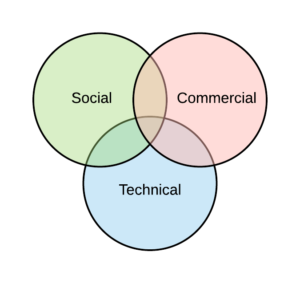
Oct 20, 2020 | News and insight
Delivering projects is a human activity. Generating something new from ‘thin air’ requires groups of people who are able to conceive, plan and then execute a series of complicated activities that will, in some form or other, enhance the lives of other human beings. Large projects require the input of many highly specialised skills, which are of limited value in themselves, but are of significant worth when combined with the skills of others. It is this combination of applied skills that lead to success. Project teams need intelligence, or more particularly three distinct types of intelligence.

- Technical intelligence – the knowledge and awareness of how to find the solution to a particular problem or opportunity.
- Commercial intelligence – the knowledge and awareness of issues around money, contracts and the identification and management of risk.
- Social intelligence – the knowledge and awareness of how humans behave in groups and teams.
Large projects require lots of people. Despite advances in automation, we remain a long way from having robots to design, manage and deliver complex engineering software, logistics or construction projects. These enterprises require human expertise and ingenuity to make them happen. As illustrated in the diagram below, there is a sweet spot at the centre of the Venn diagram where these three elements combine to form the rounded capability to lead and manage a major project. When assembling a project team, we tend to value specialist technical and commercial skills in others because they cover for gaps in our own skill or knowledge set. Adding social intelligence to the group, however, tends to be seen as much less important.
Social intelligence
We often use the word ‘dynamics’ to describe how people interact when they are together in a group or team. The word dynamics actually means ‘forces of change’. We tend to use the phrase ‘human dynamics’ when talking about how people interrelate when they come together as a group or a team. So human dynamics are essentially the forces that create or destroy the momentum of interaction between groups of individuals.
The problem is that people are messy. Humans are driven by a complex series of emotional reactions that are genetically hardwired into us to thrive and survive. Our behaviours are driven by motivational factors that are often not visible to others and can often be difficult for others to comprehend. To understand others and then have them understand you is an essential human skill. The ability to first understand others and then be understood by them is often referred to as Social Intelligence. This is a term used to describe a degree of awareness of the human interactions between oneself and others and also between others.
The concept of Social Intelligence has a variety of possible definitions but at its simplest, it is ‘an ability to get along well with others and to get them to co-operate with you’ . Daniel Goleman (2006) argues that whilst IQ is something that you are born with, social intelligence is regarded more as a learned skill, than a genetic trait. This leads us to the question that if social intelligence is an essential component of project success, then why do professional bodies pay so little attention to its development?
My observation is that there tends to be a tacit assumption in many teams that everyone on the team will automatically have the social skills needed to get along well with each other. This often turns out to be a significant misjudgement. Whilst humans have evolved to work in groups, left to our own devices we also have an amazing capacity to find reasons to disagree and dislike other people or groups. As projects have got bigger and more complex, it is clear that future generations of project leaders are going to have to take the development of their social intelligence more seriously.
Positive social interaction in project teams cannot therefore be left to chance. In just the same way as the technical and commercial competencies, there are methodologies for building strong social bonds. Those methodologies need to first be understood, learned and then practiced.
Learning and development
So if Social Intelligence is a learned skill set, the next question is how and where to acquire it.
The prevailing belief in universities and colleges appears to be that the development of social skills should be left to future employers. The problem in deferring the development of these skills is that too much effort is spent in remediating bad habits and rebuilding confidence, rather than providing the more advanced social competences needed to help individuals and teams thrive in a complex environment. It is interesting to note the outcome of a survey of teachers, reported in an article in the Times Literary Supplement dated 30 August 2017. The article highlighted the statistic that 91 per cent of respondents felt that schools should be doing more to help their pupils develop teamwork and communications skills.
There is a tendency to call the ability to understand and communicate a ‘soft’ skill, the implication being that learning how to connect with other people is an imprecise art rather than a precise process. I believe this is an outdated description emanating from a time when managers lacked both the knowledge and the need to recognise the practice and process of efficient and effective team development. The other argument for degrading social skills to the category of ‘soft’ is a belief that they cannot be measured and therefore cannot be managed. This again is simply lazy thinking. There is no difference in my mind in assessing someone’s technical, commercial or social capabilities. It is simply a matter of choosing the metrics and then making the effort to collect the data.
Organisations will periodically invest in soft skills training in areas such as presentations, negotiation, time management and communication.
These are active elements which reflect the ‘tell’ mindset predominant in western organisations. Social intelligence is a wider concept, which involves more than just what one person says or does. To be able to influence what happens in a team, you need to understand what is going on, not only when the individuals react to each other and how they collectively respond to events that impact on the team. Social intelligence learning therefore includes areas such as:
- Systemic thinking. Seeking to identify all of the different factors that have created a situation. It involves techniques to look at a problem or issue from a number of different perspectives.
- Understanding group dynamics. Learning how to ‘read the room’ to gauge what is happening underneath the surface behaviours of the team.
- Influential enquiry. Controlling and steering conversations through the use of skilled questions.
- Conflict management. Managing difficulties and problems by creating an atmosphere that encourages dialogue rather than heated debate
- Psychometrics. Understanding others by learning to recognise their motivations and preferences and adapting your messages so they recognise your point of view more quickly.
- Sensory awareness. Knowing how to really listen to what others are communicating not just in words but in posture, eye movement, facial expression and pace of voice.
- Reflection. The habit of methodically taking time to think about recent experiences and consider what happened, why it happened, and what to do the next time a similar situation occurs.
The skills set out above can be taught but as with any skill, must be practiced to become proficient. These skills must be learned and developed in the same ways one acquires technical and commercial skills. The initial information can be acquired in the classroom, or from books. A good place to start would be to check out my website, www.teamcoachingtoolkit.com. The real learning only comes however, when trying to apply this knowledge in a real-life situations.
Managing Behavioural Risk
This article has focused on the need for project leaders to pay attention to the social or people based factors in addition to the technical and commercial challenges that every project must deal with. Successful projects almost always feature successful teams where collaborative behavioural norms had been embedded early in the project life cycle. Ineffective teams will always struggle to deliver on their promises and so anyone studying the risk of default must pay attention to the dynamics present within the core team.
As projects continue to grow in size and complexity paying attention to the level of social intelligence in you team may well be the difference between success and failure. I would therefore urge any leader looking for a better way of reducing the risk of project failure to explore the investment in developing the social competences outlined above. A team with the full range of strong technical, commercial and social skills is much more likely to build a success story.
Tony Llewellyn
References
- Golman, D (2006) The new science of human relationships, Random House
- Ward H, (2017) Teachers rate soft skills as more important than good grades. Times Educational Supplement, 30 August 2017. https://www.tes.com/news/school-news/breaking-news/teachers-rate-soft-skills-more-important-good-grades (accessed on 5 Jan 2018)

Sep 30, 2020 | News and insight
The benefits of developing collaborative relationships between teams working on large projects are easy to recognise, particularly when operating in a complex and uncertain environment. Studies of successful projects almost always identify the creation of strong social bonds between sub teams who rely on each other to complete their tasks. And yet I continually encounter stories of project leaders declining to invest the time and resources needed to establish the processes, structures and behavioural norms that are needed to create a collaborative environment.
For example, I recently came across a project that is about to make the transition from the design stage into mobilisation for delivery. The project is complex and the early stages have been difficult, but the original project leader had the foresight to employ a specialist firm to help the different teams work as a collaborative unit. Moving into the delivery stage, a new project director has been appointed, who has decided not to carry this specialist support through into the delivery phase. The stated reason given is because there is no budget, but I have heard stories on a similar theme so often, it is worth looking a bit deeper. In the course of my research into successful and unsuccessful projects, it has become apparent that a large proportion of project leaders and their advisers are prone to a concept that might be called the Collaboration Fallacy.
This is a phenomenon in which senior decision makers involved in large projects make an assumption that despite the evidence of their own experience, all of the teams and groups involved in the enterprise will naturally work collaboratively together in pursuit of a single collective goal. It then comes as an unpleasant surprise when project performance starts to deteriorate and the project agenda becomes derailed by inter team conflict and blame.
Most project management professionals are aware of the concept known as the ‘Planning Fallacy’, whereby humans continually underestimate how long an element of a project is likely to take to complete. The term was coined by David Khaneman and Amos Trevisky in 1979 and is an extension of our tendency towards optimism bias. The primary insight Khaneman and Trevisky offered was that we often make such errors of judgement in forecasting the future, even when the evidence that would predict of a more realistic outcome is readily available to us.
Over the past eight years, I have collected enough evidence to show that project teams are likely to be more effective when they invest in establishing the processes, systems and behavioural norms that encourage the different sub-teams working on a major project to communicate, cooperate and collaborate. The problem is that this requires time and resources to be used at the start of a project just when everyone is under pressure to immerse themselves into the technical detail. The prevailing belief is that project professionals
should be able to behave logically and rationally and that cooperation and collaboration should automatically happen irrespective of circumstances. This is a flawed assumption. The reality of human behaviour in groups should lead us to the opposite assumptions for the following reasons:
1. Tribal tendencies – whilst humans are wired to work with others, our preference is to stay in small groups, usually of between 3 and 10 people. Grow beyond that number and we will instinctively start to form sub-groups. Whilst humans are wired to work cooperatively with each other to find food and safety, we are also instinctively tribal. Once we have formed into a satisfactory group, we begin to define our team by its differences to others. We are also naturally competitive so will seek to gain small advantages over other teams within the same organisation.
2. Organisational siloes. If human nature was not enough, organisations habitually structure themselves into departments, grouped by random factors such as skillset or geographic location. The prevailing obsession with control often means that communication is designed to move up and down the vertical ‘siloes’ shown on the org chart so that all important (as well as a lot of unimportant) information moves to the top of the hierarchy and directions are passed down. Any communication between vertical siloes is limited to senior leaders who are often competing with each other for influence. Cross team communication is consequently limited to random individual relationships between people who happen to know each other.
3. Systemic barriers. The vast majority of organisations put structural barriers in place between themselves and their supply chain, where procurement teams and their consultants insist on the use of transactional mechanisms. These inevitably send the parties onto a course where each is battling to protect their own position, rather than working in partnership to solve collective problems.
These barriers exist to a greater or lesser extent in every major project, both within internal teams and external contractors. The more people involved in the project, the more likely one is to find evidence of miscommunication, non-cooperation and dysfunctional behaviour. Anyone who has been involved in a project involving many groups of people knows this to be true.
So why despite the evidence of own experience, do we continue to expect that people will instinctively, systemically and culturally collaborate? The answer of course lies in the misplaced optimism, which brings us back to the concept of the Collaboration Fallacy where we make an unrealistic assessment of the future scenario without thinking through what is likely to happen if we take a past experience into account.
The bottom line is that large projects fundamentally rely on effective communication between teams who are dependent on each other to deliver their component of the project. The challenge for project leaders is to decide how to create a project environment where the different sub-teams build the right relationships at the right time. The positive news is that the above barriers can be overcome through the use of a set of processes, and methodologies, which can successfully counter our tribal and transactional tendencies to build a collaborative environment.
Just how these processes work will be the subject of the part 2 or this article, but to close this piece off, I would like to reinforce the core message that collaboration and co-operation are not natural or instinctive habits in teams working in complex projects environments. If you recognise the need for your teams to work together to resolve the vast array of problems and difficulties that are likely to arise on your next project, then don’t succumb to the Collaboration Fallacy, and take time to make sure that the problems your teams have experienced in the past do not continue in the future.
Any discussion on teams is often multi faceted, generating many different views. So what are your thoughts on the Collaboration Fallacy?
Tony Llewellyn

Oct 20, 2020 | News and insight
The COVID-19 crisis has forced teams to continue working together using electronic media. Many organisations are finding that at least temporarily, they can operate on a virtual basis, giving much credence to the argument that remote working is at least as effective as office-based operations. However, a question that has been playing on my mind over the past three weeks is; how much knowledge are we missing from the part of natural communications process that might be called our ‘peripheral vision’? Peripheral vision is how I would describe what enables us, often accidentally, to discover that someone else has found a solution to a problem we are struggling to solve, or those moments we find a connection to an option which we were previously unaware of. A couple of simple questions highlight my point:
- How often do you gain the most valuable insights while having a conversation over making a coffee prior to a planned meeting, rather than during the meeting itself when following a pre-set agenda?
- How often within an office environment do you hear a snippet of a conversation which makes you stop what you are doing and go and find out more?
I sense that this information gap is going to increasingly impact our ability to move projects forward as the return to working in an office environment looks even more distant. My concern is whether the working habits we are developing at this time are nudging us unintentionally into siloes, where connection and communication across sub-team boundaries become limited. So, what mechanisms could we try and develop to help replace this missing source of information in a distributed team? I can think of three potential areas:
- Behavioural – Part of the answer might be to become more expansive in our thinking about our current work and how it might be used. Who else might find it useful to know what we are working on and the challenges we are struggling with?
- Becoming a ‘learning team’ – The benefits of recycling learning back into a team are a well understood feature of high performance. Adopting the habit of regular review of what has happened and what could we do to improve, will push a team to extend their peripheral vision. By pausing to reflect, team members increase their chances of thinking laterally to explore new connections.
- Explore technology – One example that I am interested in exploring further is the use of software to analyse communications and connect people within an organisation who are not already connected but are having conversations with others about similar topics. The increase in the availability of free-text theming software could really support knowledge management in a new way.
My purpose in writing this short article is not to prescribe the answer, but to try and stimulate some discussion about how we continue to adapt our working practices to ensure we can be as effective working in distributed team. I would therefore love to hear your thoughts and opinions on this issue.
Edward Moore

Sep 27, 2020 | News and insight
Welcome to the new ResoLex website!
We have taken some time to update our online presence to better reflect our brand and values and showcase our approach to working with major project teams. Visit ‘About Us’ to find information about who we are and how the business has developed over the last 20 years. We have updated information on past projects delivered and we also have a new list of services to give a flavour of what we can offer.
Please do access our resources and join our Community by signing up to receive our newsletter. If you have a specific query or would like to talk to a member of the team, we would love to hear from you. Details are on the ‘Contact Us’ page.




